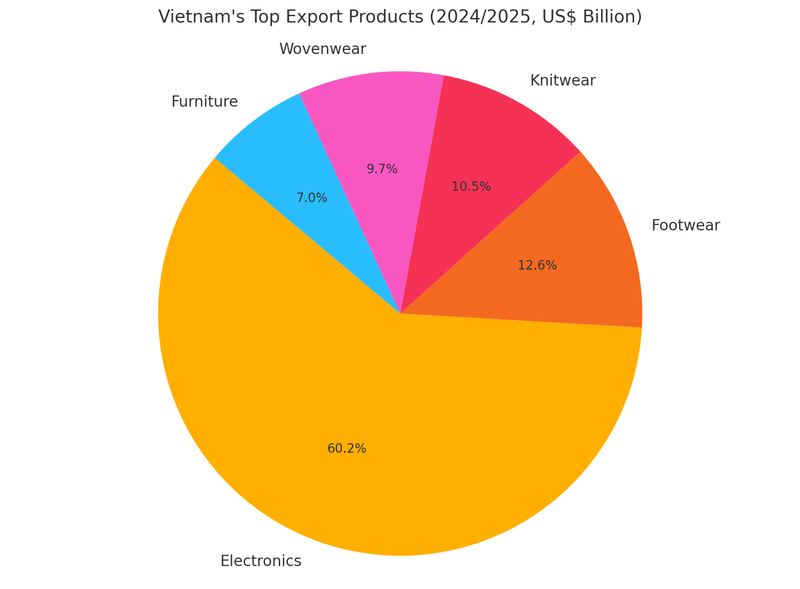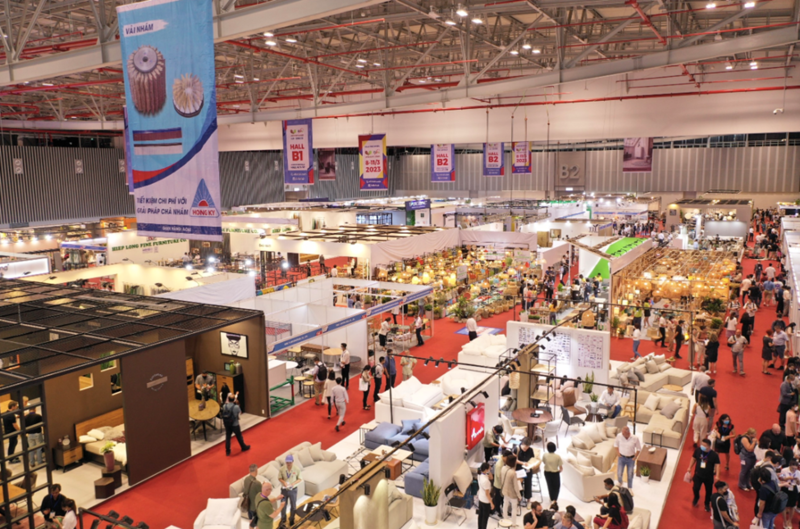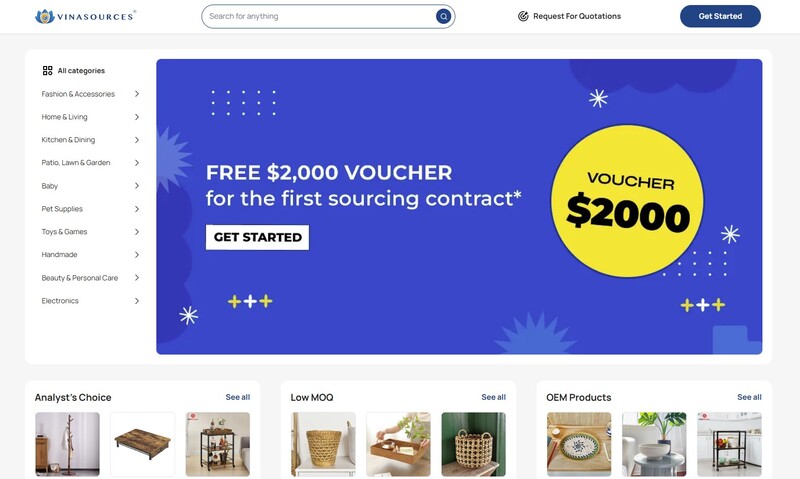Vietnam has long been a good China alternative for sourcing. Ever since the China-US trade war in 2018, many sourcing leaders, such as Nike, Adidas and IKEA, have sought to buy products from Vietnam suppliers thanks to competitive FOB pricing, stable quality at scale and FTA-qualified origin. So, how do I find suppliers in Vietnam, you may ask. In this article, we will give you a practical guide and a complete roadmap to help you search and reach out to the most suitable Vietnamese manufacturers.
Why Is Vietnam A Top Destination For Product Sourcing?
The global sourcing landscape has witnessed a huge shift away from China because of the intense trade war between the country and the U.S. The rising costs regarding labor and tariff, alongside geopolitical risks, pushed many brands to adopt a China+1 approach to diversify their supplier base.
Among alternative sourcing countries, Vietnam continues to emerge as a top-performing hub for labor-intensive manufacturing. Statistically speaking, Vietnam export market recorded US $405.5 billion in 2024, a notable leap from US $379 billion in 2023.In the first quarter of 2025, the total export turnover reached US $102.8 billion. The country’s top export products include electronics, footwear, knit apparel, woven apparel, and wooden furniture.

So, why is Vietnam rising above other China sourcing alternatives? Here come the key reasons:
- Labor cost: Vietnam’s labor cost averages US$3 per hour, much lower than China’s US$6 to US$7. This allows more competitive FOB pricing.
- FTA access: The country has 16 active FTAs, including EVFTA, CPTPP, and bilateral deals with Japan, South Korea, the UK, and Australia, with tariff cuts up to 9 percent effective beyond 2030.
- Export position: Vietnam ranks second in global footwear exports and third in textiles and garments, with furniture exports over US$14.2 billion.
- Logistics capability: Key ports like Cat Lai and Hai Phong offer efficient handling, and sea freight to the US West Coast takes around 20 to 25 days.
- Factory compliance: Thousands of factories hold certifications like BSCI, ISO 9001, WRAP, and FSC, supporting global compliance requirements.

How to Find Suppliers in Vietnam: 5 Common Methods
With all that said, Vietnam offers clear advantages for global buyers looking to diversify their supply chains. Now, you may be wondering: How do I find suppliers in Vietnam? In the following section, we’ll break down 5 practical ways.
#1. Search Google with Vietnamese Industry Keywords
This is probably the first method that comes to mind for most new importers. Basically, you go to Google and type in the product name along with terms like “manufacturer”, “supplier”, or “factory” together with “Vietnam” or “Vietnamese”.
One advantage of this method is speed. You can get dozens of potential supplier links within seconds, including company websites, directories, and Facebook business pages.
However, not all results are reliable. Many Vietnamese suppliers still handle their online presence manually. They don’t invest in SEO (search engine optimization, which helps websites appear in top search results).
Some Vietnam suppliers websites are created just to exist, without real content or updates. Others don’t have a website at all, especially small or family-run factories. So, even good suppliers may not show up in your search. Some links might also lead to inactive or outdated pages.
So, how do you search Vietnam suppliers more effectively on Google? Here are some practical tips:
- Add the word “Việt Nam” or specific location to filter local suppliers. You can use Google Translate or tools like ChatGPT to find the correct Vietnamese terms.
- Use product type + production term in Vietnamese instead of English
- Include keywords like “OEM”, “gia công”, “xuất khẩu” for B2B results
- Try combinations with “xưởng”, “nhà máy”, “nhà cung cấp”, “cơ sở”
- Use Google operators like quotes or filetype to refine search
#2. Join Facebook Groups Where Vietnamese Manufacturers Are Active
Vietnam treats Facebook not just as a social platform, but also as a business tool. Unlike in many countries where sourcing happens through LinkedIn or email, Vietnamese buyers and suppliers often connect, chat, and even close deals directly via Facebook. Many manufacturers and factory owners actively post in private groups or reply to sourcing inquiries there.
The upside is fast, direct access to real suppliers. You just post your sourcing request or browse existing posts in relevant groups. This is a common way to reach small factories that don’t appear on Google or B2B platforms.
The downside is that credibility is hard to verify, and fake accounts or stock photo scams are not uncommon. Another inconvenience is that most group posts and comments are in Vietnamese.
Some useful groups you can try:
- Sewing Factories & Buyers Matching Hub
- Printing & Packaging Suppliers Vietnam
- Vietnam Footwear Sourcing Network
A small tip here is to message suppliers directly and ask for their website, Zalo number, physical address, and tax code (mã số thuế). You can verify their legitimacy using two official portals dangkykinhdoanh.gov.vn (managed by the Ministry of Planning and Investment) and tracuunnt.gdt.gov.vn ((run by the General Department of Taxation Vietnam).

#3. Work with Vietnam-Based Sourcing Agents
Sourcing agents are local experts that help you navigate communication, factory vetting, sample coordination, and site visits effectively. They know which Vietnam manufacturers are legitimate, what price ranges are reasonable, and which factories specialize in export-ready production. Some even have direct connections with factories that may not appear on Google or international platforms.
If you’re new to sourcing in Vietnam or don’t have time to sift through dozens of factory leads, partnering with a sourcing agent is a solid option. Be cautious about commission-based arrangements, though. Many Vietnam-based agents work on commission paid by the factory, which may affect their neutrality. Some may push factories they’re tied to, not necessarily the best fit for your needs.
Besides word of mouth, you can find sourcing agents in Vietnam via sourcing directories or Google. Some agents also advertise their services in Facebook groups and B2B platforms like Alibaba or LinkedIn. When searching, try:
- Vietnam sourcing agent + [product]
- Vietnam buying office
- freelance sourcing consultant Vietnam
#4. Attend Trade Shows in Vietnam to Meet Manufacturers Face-to-Face
Vietnam hosts several key trade events where you can meet and negotiate with suppliers directly. These events are held in both local venues and international-scale exhibition centers such as SECC (Ho Chi Minh City) and I.C.E. Hanoi. Most of these events are industry-focused, government-backed, and feature export-ready manufacturers across categories like furniture, textiles, food, and handicrafts.
Meeting face-to-face at trade shows offer more direct, large-scale access to verified suppliers than online search, Facebook groups, or agents. More importantly, many Vietnamese products, such as furniture, garments, handicrafts, and footwear, require hands-on inspection to assess finish quality, stitching accuracy, material type, or customization capability that can’t be judged accurately through photos.

However, trade shows require time, travel, and preparation. So, this method is best suited for buyers with large-volume orders or those seeking long-term manufacturing partners.
Key trade shows in Vietnam for sourcing (domestic & international)
| # | Trade show | Time (Annually) | Highlights | Industry focus |
| 1 | Vietnam International Apparel & Textile Trade Show (I.C.E., Hanoi) | February | Jointly organized by Messe Frankfurt and VINATEX. ASEAN-wide scope. | Apparel, textile, fashion tech |
| 2 | Vietnam Furniture & Home Accessories (SECC, Ho Chi Minh City) | February | Seasonal version of VIFA, featuring export-ready SMEs. | Home decor and furniture |
| 3 | VIFA EXPO (SECC & SKY EXPO, Ho Chi Minh City) | March | Largest furniture fair in Vietnam. 3,000+ booths. | Furniture, home accessories |
| 4 | HawaExpo (SECC, Ho Chi Minh City) | March | Backed by Vietnam Wood Associations. Offers factory tours. | Wood furniture, handicrafts |
| 5 | Global Sourcing Fair Vietnam (SECC, Ho Chi Minh City) | April | Organized by Global Sources. 700+ booths, export-ready suppliers. | Apparel, homeware, furniture, crafts |
| 6 | Vietnam Fashion Fair (SECC, Ho Chi Minh City) | April | Smaller event for sourcing local brands and trend items. | Fashion, seasonal wear, accessories |
| 7 | Vietnam Expo (I.C.E. Hanoi) | April | Government-led, includes international pavilions (Korea, China, Belarus); supports SME sourcing. | Multi-sector trade promotion, including manufacturing & export services. |
| 8 | Vietnam International Sourcing Expo (SECC, Ho Chi Minh City) | September | Government-backed expo with 500+ booths. Strong national supplier base. | Consumer goods, lifestyle, gifts |
Besides the major shows in Q1–Q3, Vietnam does host several industry-specific fairs in late 2025, such as Vietnamwood Hanoi, SIUF (intimate apparel sourcing), and the Vietnam Hardware & Hand Tools Expo in December.
#5. Use Vietnam-Based Supplier Platforms and Directories
While Vietnam doesn’t have a centralized platform like Alibaba, there are several local directories and websites worth checking out. These include official export portals, curated sourcing networks, and directories managed by Vietnamese trade organizations.
The advantage of using these directories is that they provide more legitimate supplier listings than general Google search or Facebook groups, especially for export-ready manufacturers. Compared to other methods, they may not offer real-time interaction like Facebook or the factory access of agents, but they strike a good balance between discoverability and credibility.
Some Vietnam-based directories to explore:
- VietnamExport: Official portal by Vietnam’s Ministry of Industry and Trade for verified export companies
- Vietnam Manufacturers: Product-based directory with catalogs and basic factory info
- Vietnam B2B Direct: Pre-vetted supplier listings with sourcing and QC services
Regarding B2B sourcing platforms, VinaSources is often referred to as the closest alternative to Alibaba in Vietnam. It connects global buyers to verified Vietnamese suppliers with product listings, RFQ tools, factory credentials, and compliance information.

Potential Challenges of Sourcing From Vietnam
Despite being a fast-growing sourcing destination, Vietnam still lacks critical infrastructure, capabilities, and systems that buyers must actively manage.
1. Language barrier
Many suppliers are not fluent in English or familiar with international business practices, leading to frequent miscommunication during quoting, sampling, and contracting.
2. Factory scale limits
Most are small to mid-sized workshops lacking automation and certifications like ISO 9001 or BSCI. As a result, they often struggle with large orders or complex specs.
3. Longer lead times compared to China
Average lead times range from 45 to 90 days. Additionally, factories shut down for 7 to 14 days during Tet (Lunar New Year) and often require another week to return to normal operations.
4.Material dependence
Vietnam relies heavily on imported raw materials from China and South Korea, especially in textiles, electronics, and plastics. This dependence increases the risk of delays and price volatility.
5. IP enforcement gaps
Although IP laws exist, enforcement remains weak. It’s not uncommon for suppliers to copy designs, leak specifications, or resell products to other buyers without permission.
6. QC inconsistency
Many factories, especially smaller ones, do not have dedicated QC teams. This can result in issues such as size inaccuracy, stitching defects, poor surface finish, or incorrect labeling and packaging.

Additional Tips and Best Practices For Finding Vietnam Manufacturers
Finding reliable manufacturers in Vietnam takes more than just knowing where to search. Below are practical tips to help you qualify suppliers, avoid scams, and ensure smoother collaboration.
- Always request a business license and tax code: Ask for their Vietnamese business registration and verify it on dangkykinhdoanh.gov.vn.
- Use Google Translate or ChatGPT to convert keywords like “xưởng sản xuất”, “gia công theo yêu cầu”, or “nhà máy OEM Việt Nam” to boost search accuracy.
- Ask for Zalo or official company email: Most real suppliers in Vietnam use Zalo (a local app) for business messaging.
- Avoid Gmail-only suppliers with no website unless referred directly or verified via government listings.
- Double-check factory photos: Reverse-search product or factory images to check for stock photos or stolen images.
- Visit or audit if possible: Even a virtual tour helps validate production scale and transparency.
In addition, always check the factory’s certifications such as ISO, BSCI, or FSC to ensure they meet international quality standards and are capable of stable exports.
Conclusion
That concludes our guide on how to find suppliers in Vietnam. To sum up, finding Vietnam manufacturers through trade shows remains the most effective. For online sourcing, VinaSources is the best option because it is the only Vietnam‑based B2B sourcing platform built specifically for global buyers and Vietnamese export-ready factories.
VinaSources connects global buyers with export-ready factories and verified manufacturers. It is currently the only sourcing platform in Vietnam with clear, well‑designed company profiles, with MOQs listed by product category and built-in chat support.
Want to try it yourself? Feel free to visit VinaSources and request a quote!
